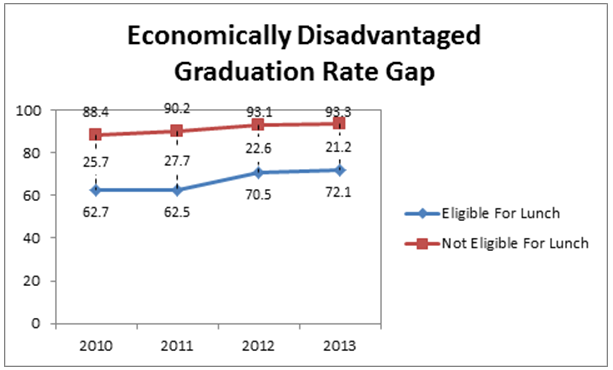Research
Blog #10: Final Abstract, Bibliography, and Link to Your Paper
Present
an abstract of your final project and include your complete bibliography of
sources. These two items will be very
helpful to other people who want to learn more about your project. Remember that both also need to be included
with your final paper also. These must
be posted online by April 29th at the latest.
The
United States prides itself in equal opportunities for all and access to higher
education tops the list. There are opportunities and programs that enable less
financially privileged students to attend a college or university — government
and state funded loans or grants are available, as well as short-term programs
that help struggling applicants prepare for a college education. Additional guidance
counselors in lower income areas also have been found to help high school
students determine the best school. These resources and financial aid make
higher learning a graspable goal, but that is only half the battle.
Successfully completing a degree is the troubling journey.
College
completion rates for wealthy students have soared in 40 years, but the same
cannot be said for low income young adults in school, leaning to a yawning gap
in graduation rates that could have lasting implications for the socioeconomic
divide.
According
to “Big Gap in College Education Rates between Rich and Poor,” of the Wall
Street Journal, the rift between students of wealthy families and students of
poor areas is continuing to grow, without any signs of slowing down. The Pell
Institute for the Study of Opportunity in Higher Education recorded that in
2017, 77% of adults from families in the top income quartile earned at least a
bachelor’s degree at the age of 24, which is a 40% increase since 1970. On the
contrary, the amount of students earning at least a bachelor’s degree in the lowest
income quartile increased only from 6% in 1970 to 9% in 2013. This shows the
amount of students receiving a bachelor’s degree at the age of 24 is increasing
as a whole, but financially struggling populations are lagging behind. In order
to decrease the gap of academic achievement between students belonging to
different income classes, academic programs that focus on developing a student’s
ambitions while providing psychological and financial support must be
implemented especially at an earlier age.
Works Cited
1.
"Big Gap in College Graduation Rates for Rich and
Poor, Study Finds." The
Wall Street Journal. Dow Jones & Company, 03 Feb. 2015. Web. 17 Dec.
2016.
2.
"The
Stewardship of Higher Education : Re-imagining the Role of Education and
Wellness on Community Impact." (eBook,
2013) [WorldCat.org]. N.p., 25 Nov. 2016. Web. 17 Dec. 2016.
3.
"Why
Poor Kids Don’t Stay in College." The
Washington Post. WP Company, n.d. Web. 17 Dec. 2016.
4. Olsen, Hanna Brooks. "But Seriously, Let's
Talk About Millennial Poverty." Medium.
N.p., 11 Aug. 2015. Web. 17 Dec. 2016.
5. "More Than 40% of Low-Income Schools Don't
Get a Fair Share of State and Local Funds, Department of Education Research
Finds." More Than 40% of
Low-Income Schools Don't Get a Fair Share of State and Local Funds, Department
of Education Research Finds | U.S. Department of Education. N.p., n.d. Web.
17 Dec. 2016.
6. Tough, Paul. How
Children Succeed: Grit, Curiosity, and the Hidden Power of Character.
Boston: Houghton Mifflin Harcourt, 2012. Print.
7. McLeod, Saul. "Maslow's Hierarchy of
Needs." Simply Psychology.
N.p., 16 Sept. 2013. Web. 17 Dec. 2016.
8. Armstrong, Elizabeth A., and Laura T. Hamilton. Paying for the Party: How College
Maintains Inequality. Cambridge, MA: Harvard UP, 2013. Print.
9. "The Institute For College Access and
Success." What We Do |
The Institute For College Access and Success. N.p., n.d. Web. 17 Dec. 2016.
10. How the $1.2 Trillion College Debt Crisis Is
Crippling Students, Parents and the Economy. N.p., n.d. Web.
11. Gorman, Ryan. "How Student-loan Debt Is
Dragging down the Economy." Business
Insider. Business Insider, 01 May 2015. Web. 17 Dec. 2016.
12. "Why Poor Kids Don’t Stay in
College." The Washington
Post. WP Company, n.d. Web. 17 Dec. 2016.
13. "Home." Learning Environments | 2014.
N.p., n.d. Web. 17 Dec. 2016.
14. Bair, Sheila. "The Real Reasons College
Students Drop Out." Fortune.
N.p., 07 Mar. 2016. Web. 17 Dec. 2016.
15. Dwyer,
Rachel, McCLoud, Laura and Hodson, Randy. Debt
and Graduation from American Universities . Print
16. Collinge, Alan. The Student Loan Scam: The Most
Oppressive Debt in U.S. History, and How We Can Fight Back. Boston, MA:
Beacon, 2009. Print
17. "ERIC - Educational Aspirations among
Low-Income Youths: Examining Multiple Conceptual Models, Children &
Schools, 2010-Apr." ERIC
- Educational Aspirations among Low-Income Youths: Examining Multiple
Conceptual Models, Children & Schools, 2010-Apr. N.p., n.d. Web. 17
Dec. 2016.
18. Tough, Paul. "Who Gets to Graduate?" The New York Times. The New
York Times, 17 May 2014. Web. 17 Dec. 2016.
19. Weissmann, Jordan. "Smart Poor Kids Are
Less Likely to Graduate From College Than Middling Rich Kids." Slate Magazine. N.p., 02 June
2015. Web. 17 Dec. 2016.
20. "Why Are Low Income Students Not Showing
up to College, Even Though They Have Been Accepted? - The Hechinger
Report." The Hechinger
Report. N.p., 03 Nov. 2015. Web. 17 Dec. 2016.
21. Merriam-Webster. Merriam-Webster, n.d. Web. 17 Dec. 2016.
22. "Rutgers Future Scholars." Rutgers Future Scholars. N.p.,
n.d. Web. 17 Dec. 2016.



